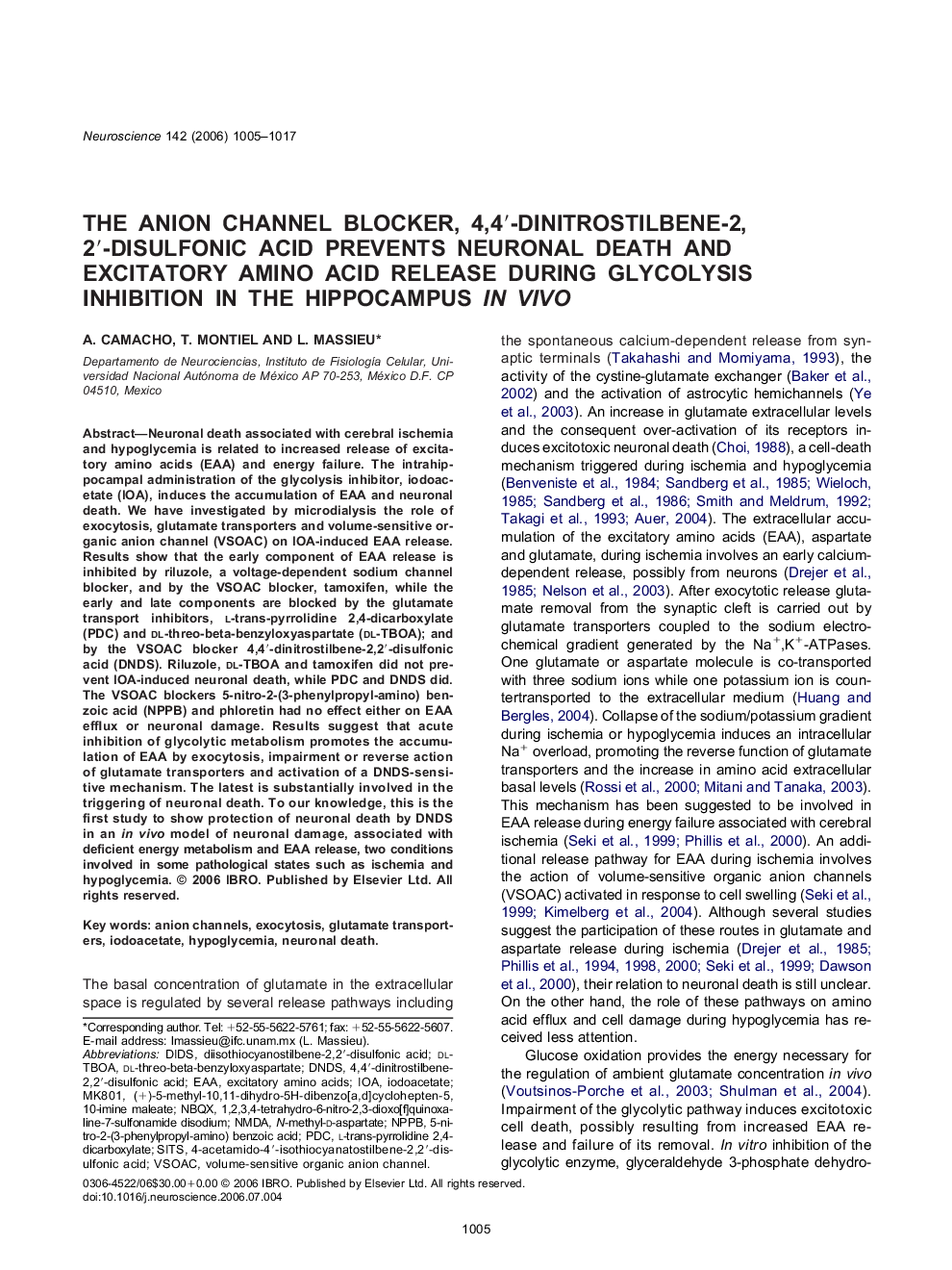| کد مقاله | کد نشریه | سال انتشار | مقاله انگلیسی | نسخه تمام متن |
|---|---|---|---|---|
| 4341562 | 1295840 | 2006 | 13 صفحه PDF | دانلود رایگان |
عنوان انگلیسی مقاله ISI
The anion channel blocker, 4,4â²-dinitrostilbene-2,2â²-disulfonic acid prevents neuronal death and excitatory amino acid release during glycolysis inhibition in the hippocampus in vivo
دانلود مقاله + سفارش ترجمه
دانلود مقاله ISI انگلیسی
رایگان برای ایرانیان
کلمات کلیدی
MK8014-acetamido-4′-isothiocyanatostilbene-2,2′-disulfonic acid(+)-5-methyl-10,11-dihydro-5H-dibenzo[a,d]cyclohepten-5,10-imine maleate4,4′-dinitrostilbene-2,2′-disulfonic acidVSOACDNDSSITSNBQXNppbEAADIDSN-methyl-d-aspartateNMDAPDCdl-TBOA - DL-TBOAexcitatory amino acids - اسیدهای آمینه هیجان انگیزExocytosis - اگزوسیتوزglutamate transporters - حمل و نقل گلوتاماتNeuronal death - مرگ نورونhypoglycemia - هیپوگلایسمی anion channels - کانال های آنیونیIodoacetate - یو دی اتاناتIoA - یوآآ
موضوعات مرتبط
علوم زیستی و بیوفناوری
علم عصب شناسی
علوم اعصاب (عمومی)
پیش نمایش صفحه اول مقاله

چکیده انگلیسی
Neuronal death associated with cerebral ischemia and hypoglycemia is related to increased release of excitatory amino acids (EAA) and energy failure. The intrahippocampal administration of the glycolysis inhibitor, iodoacetate (IOA), induces the accumulation of EAA and neuronal death. We have investigated by microdialysis the role of exocytosis, glutamate transporters and volume-sensitive organic anion channel (VSOAC) on IOA-induced EAA release. Results show that the early component of EAA release is inhibited by riluzole, a voltage-dependent sodium channel blocker, and by the VSOAC blocker, tamoxifen, while the early and late components are blocked by the glutamate transport inhibitors, l-trans-pyrrolidine 2,4-dicarboxylate (PDC) and dl-threo-beta-benzyloxyaspartate (dl-TBOA); and by the VSOAC blocker 4,4â²-dinitrostilbene-2,2â²-disulfonic acid (DNDS). Riluzole, dl-TBOA and tamoxifen did not prevent IOA-induced neuronal death, while PDC and DNDS did. The VSOAC blockers 5-nitro-2-(3-phenylpropyl-amino) benzoic acid (NPPB) and phloretin had no effect either on EAA efflux or neuronal damage. Results suggest that acute inhibition of glycolytic metabolism promotes the accumulation of EAA by exocytosis, impairment or reverse action of glutamate transporters and activation of a DNDS-sensitive mechanism. The latest is substantially involved in the triggering of neuronal death. To our knowledge, this is the first study to show protection of neuronal death by DNDS in an in vivo model of neuronal damage, associated with deficient energy metabolism and EAA release, two conditions involved in some pathological states such as ischemia and hypoglycemia.
ناشر
Database: Elsevier - ScienceDirect (ساینس دایرکت)
Journal: Neuroscience - Volume 142, Issue 4, 3 November 2006, Pages 1005-1017
Journal: Neuroscience - Volume 142, Issue 4, 3 November 2006, Pages 1005-1017
نویسندگان
A. Camacho, T. Montiel, L. Massieu,